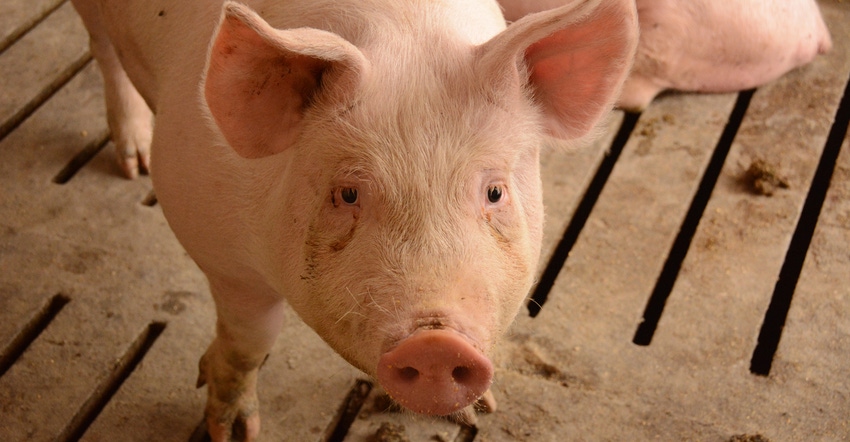
How do you keep African swine fever out of U.S. hog herds? USDA has developed a plan with rules for imports. And if the disease does arrive in this country, state ag departments are already working with pork producers to limit its spread.
Here’s how the plan would work in Illinois: After veterinarians and herd managers identify possible ASF presence, Illinois State Veterinarian Mark Ernst and his team would confirm it and send a sample to USDA. If positive, U.S. Secretary of Agriculture Sonny Purdue would issue an order to stop movement of swine for 72 hours nationwide. The system relies on people on the ground.
“Our hope would be that in those facilities where a veterinarian does make the rounds monthly or so, that the herd manager would be a little more observant — not that they aren’t already — but be a little more conscious about saying, ‘You know, we’re going to let the state know there’s something going on here,’ rather than watching it for a few days,” Ernst says, referencing telltale signs of infection such as septicemia and higher-than-average death rates.
If people are already hauling animals when the stop-movement order goes out, there’s a 10-hour period at the start of the nationwide quarantine for producers to get to their destination. Following the 72-hour stop-movement order, new documentation would be required to move live animals to processors and other buyers.
Producers would need to submit an increased biosecurity plan to the Illinois Department of Agriculture, and apply for a premises identification number before applying for a movement permit required to move swine after the 72-hour stop-movement order is issued.
“We’ve been encouraging Illinois producers to get their premises registered with us so we can get some of that work done ahead of time in the event that we would have an outbreak,” Ernst says.
The registration lets the state know where a herd is and its population. If an Illinois farm is infected, a 10-kilometer quarantine zone will be placed around it that no swine can enter or exit.
“After a 72-hour stop-movement, you’re not allowed to move your pigs anywhere without the premises ID and permits, but you can do all of it ahead of time, so you should get started now,” says Jenny Jackson, director of communications at the Illinois Pork Producers Association.
Event planning
The IPPA is teaming up with producers, University of Illinois Extension and IDOA for an event on Dec. 13 from 9 a.m. to 3 p.m. at the IDOA offices in Springfield. They’ll be sharing insights from a four-day USDA drill that took place at the end of September on two Illinois pork farms.
“After the stop-movement, herds will have to basically be able to show their freedom from disease in order to move,” Ernst says. “Some of the logistics behind testing are still being worked out, even on the national level. We’ll be able to discuss those with growers at the Dec. 13 meeting.”
In reviewing the results of the drill, which was meant to help the state hone any preparations it wants to make on top of USDA’s plans, Ernst says all options are on the table for disposing of carcasses, including permitting movement outside of the mandated quarantine zone on infected farms for rendering. He says it’s important for producers to line up their plans for depopulation and disposal sooner rather than later.
Jackson says both farmers participating in the drill had prepared ahead of time with their farm staff and had analyzed their farms. “The biggest questions coming out of here is depopulation and disposal,” she adds.
Options for disposal
While one farmer wanted to incinerate carcasses and then compost the ashes on-site, he soon learned IDOA doesn’t have a Type 4 incinerator powerful enough to burn all the fat. An incinerator of that kind would cost upward of a million dollars.
“It was only a drill, so we didn’t follow through on depopulation, but it’s still good to answer these questions now,” Jackson says, adding IPPA plans to unveil a composting calculator at the Dec. 13 event to help producers calculate how much carbon-heavy biomass, such wood chips or corncobs, would be necessary to decompose carcasses in a composting plan.
“There’s some work being done with some aboveground burial options similar to composting that we’re looking at, too,” Ernst says.
When asked how state police would enforce the stop-movement order during the 10-hour interval those transporting swine have to get to their destination, Ernst says since every shipment is accompanied by health papers, “it would be fairly easy to figure out if a producer left after the stop-movement was issued.”
He concludes the state police may look into using weigh stations as checkpoints for interstate movement in the event of an outbreak.
Tips to prevent ASF transmission
Here are tips for preventing ASF transmission to your hog herd:
No human food. Never allow human food brought on-site to enter animal areas. International food products pose an increased risk and should not be allowed on the farm.
No garbage. Do not feed improperly cooked garbage to pigs.
Biosecurity. Adhere to strict biosecurity measures, especially after international travel.
Wash up. Employees should shower or wash hands and arms before coming in contact with animals. Wear site-specific clothing or coveralls and boots.
No contact. Prevent direct contact between animals in your herd and feral swine.
Herd management. Isolate all animals entering or reentering the herd.
Equipment care. Wash, disinfect and allow equipment to dry before bringing on-site.
Read more about:
African Swine FeverAbout the Author(s)
You May Also Like




